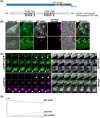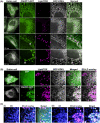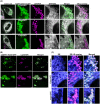This is a preprint.
The novel bacterial effector protein Cb EPF1 mediates ER-LD membrane contacts to regulate host lipid droplet metabolism
- PMID: 38168204
- PMCID: PMC10760003
- DOI: 10.1101/2023.12.11.571031
The novel bacterial effector protein Cb EPF1 mediates ER-LD membrane contacts to regulate host lipid droplet metabolism
Update in
-
A novel bacterial effector protein mediates ER-LD membrane contacts to regulate host lipid droplets.EMBO Rep. 2024 Dec;25(12):5331-5351. doi: 10.1038/s44319-024-00266-8. Epub 2024 Sep 27. EMBO Rep. 2024. PMID: 39333627 Free PMC article.
Abstract
Effective intracellular communication between cellular organelles is pivotal for maintaining cellular homeostasis. Tether proteins, which are responsible for establishing membrane contact sites between cell organelles, enable direct communication between organelles and ultimately influence organelle function and host cell homeostasis. While recent research has identified tether proteins in several bacterial pathogens, their functions have predominantly been associated with mediating inter-organelle communication specifically between the bacteria containing vacuole (BCV) and the host endoplasmic reticulum (ER). However, this study reveals a novel bacterial effector protein, CbEPF1, which acts as a molecular tether beyond the confines of the BCV and facilitates interactions between host cell organelles. Coxiella burnetii, an obligate intracellular bacterial pathogen, encodes the FFAT motif-containing protein CbEPF1 which localizes to host lipid droplets (LDs). CbEPF1 establishes inter-organelle contact sites between host LDs and the ER through its interactions with VAP family proteins. Intriguingly, CbEPF1 modulates growth of host LDs in a FFAT motif-dependent manner. These findings highlight the potential for bacterial effector proteins to impact host cellular homeostasis by manipulating inter-organelle communication beyond conventional BCVs.
Keywords: Coxiella burnetii; Effector proteins; FFAT motif; Inter-organelle contacts; Lipid droplets; Molecular tethers.
Conflict of interest statement
The authors declare no competing financial interests.
Figures






References
Publication types
Grants and funding
LinkOut - more resources
Full Text Sources
Research Materials
